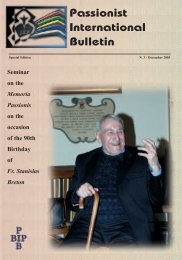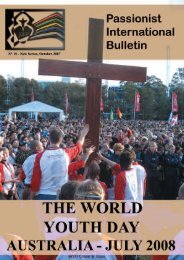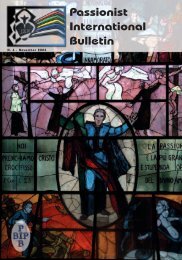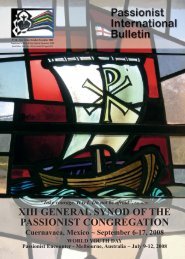Passionist International Bulletin
Passionist International Bulletin
Passionist International Bulletin
- No tags were found...
You also want an ePaper? Increase the reach of your titles
YUMPU automatically turns print PDFs into web optimized ePapers that Google loves.
The Curia InformsCONCERNING THE DISCIPLINEOF THE CULT OF RELICSFr. Giovanni Zubiani, C.P.Postulator GeneralAt this point in time in which the return to theveneration of the Relics of Saints and Beatiare confused with the collection of the sameand, at times gives way to motives that are far fromdevotion, in this article I hope to offer a short excursusto help to shed some light on the need for prudencein using these objects and to urge the observanceof the Law of the Church in this matter. Itwould seem that this is necessary in light of theappearance of relics of our saints in places that sellreligious articles and which are not prepared by thePostulator General, but which, none-the-less bearthe "de visu" unauthentic, and therefore false,<strong>Passionist</strong> seal in wax on relics of various of oursaints. These are sometimes found in the sacristiesof our <strong>Passionist</strong> nuns and Sisters and bear forgedseals, despite the protests of some Postulators, andother individuals, which go against a sense of honestyand propriety that one would suppose exists inour houses.In particular we wish to restate that relics, andeven more so the bodies of the Saints and Beati, donot belong to individuals or to religious Orders,Congregations or Dioceses, but to the Church,which oversees, in the person of the SupremePontiff through the Congregation for the Causes ofSaints, the proper use of the these materials.We also point out that with the Codeof Canon Law of 1983, the very preciselegislation that was found in the Codeof 1971 regarding the discipline of thecult of relics has been abbreviated.However, if that which was described indetail as normative has been eliminated,there is still exists in the present codeelements that have been restated fromthe preceding norms. And as such Can.19 of the 1983 text, in the case of theabsence of "express prescription of law"it states that "the jurisprudence and thepraxis of the Roman Curia, and thecommon and constant opinion oflearned persons" should be employed.It is this praxis that is applied and it isthis praxis that is followed by the postulatorsand which is permitted by the Congregationfor the Causes of the Saints.Therefore it is necessary to return to the applicationof that legislation that is recognized and usedby the Congregation for the Causes of the Saints,the particular legislation that is not found in thepresent Code of Canon Law, and which, however, isalready contained in the Code of 1917 and which isreferred to in an article by Cardinal Palazzini, thePrefect of this Congregation, in which he states: (1),"Regarding the norms provided for the discipline ofthe cult of relics: Any unofficial (not-formally recognized)relic, old or recent, whether of canonizedor beatified saints, or of those who died in odor ofsanctity, even if the relic is not officially recognizedand approved, may be venerated privately. (…)unofficial relics worthy of the same honor may beretained in privates homes or carried by the faithful(can. 1282 § I). This is not the case with legitimaterelics of the saints and beati, except with the permissionof the Ordinary of the locale (can. 1282 §I). (2) In order for relics to be used in public worshipprior ecclesiastical authorization is alwaysrequired, by which a decision is made regarding theauthenticity of the relic that is being displayed forpublic veneration.Authentics documentation and relic with wax seal21
















